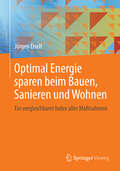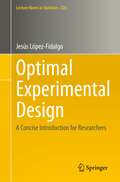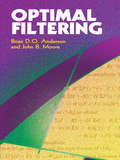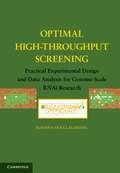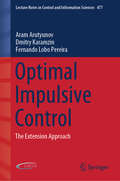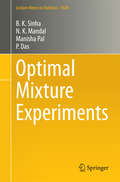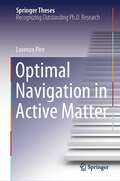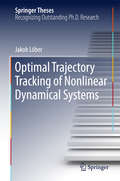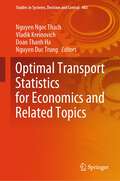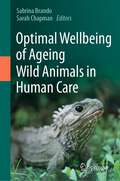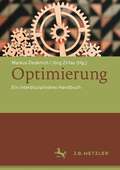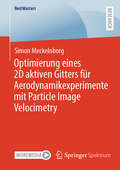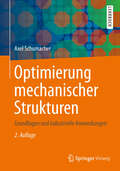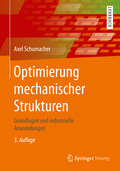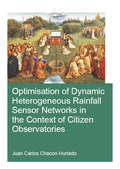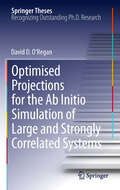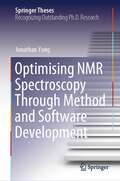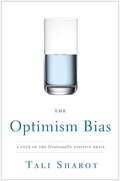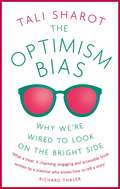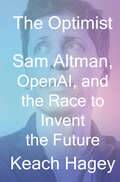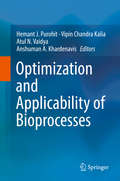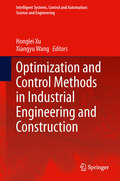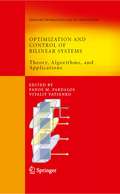- Table View
- List View
Optimal Energie sparen beim Bauen, Sanieren und Wohnen: Ein vergleichbarer Index aller Maßnahmen
by Jürgen EiseltFür Energiesparmaßnahmen im Wohnungsbestand gibt es zahlreiche Möglichkeiten. Doch welche sind wirtschaftlich sinnvoll? Welche Maßnahmen lohnen sich für Eigentümer und gibt es auch Möglichkeiten für Mieter Energie einzusparen? Zu diesen Fragen gibt das Buch Antworten und will Strategien aufzeigen, wie intelligente und wirtschaftliche Einsparlösungen erreicht werden können. Dabei werden Energie für den Heizungsbedarf und der häusliche Stromverbrauch gemeinsam betrachtet. Dadurch unterscheiden sich die im Buch präsentierten Vorschläge von der bisher üblichen Herangehensweise. Energieberater werden neue Anregungen finden und Eigentümer sowie Mieter sehen sich in die Lage versetzt, Energiesparmaßnahmen eigenständig anzugehen und vorgeschlagene Projekte kritisch zu hinterfragen.
Optimal Experimental Design: A Concise Introduction for Researchers (Lecture Notes in Statistics #226)
by Jesús López-FidalgoThis textbook provides a concise introduction to optimal experimental design and efficiently prepares the reader for research in the area. It presents the common concepts and techniques for linear and nonlinear models as well as Bayesian optimal designs. The last two chapters are devoted to particular themes of interest, including recent developments and hot topics in optimal experimental design, and real-world applications. Numerous examples and exercises are included, some of them with solutions or hints, as well as references to the existing software for computing designs. The book is primarily intended for graduate students and young researchers in statistics and applied mathematics who are new to the field of optimal experimental design. Given the applications and the way concepts and results are introduced, parts of the text will also appeal to engineers and other applied researchers.
Optimal Filtering
by John B. Moore Brian D. AndersonThis graduate-level text augments and extends beyond undergraduate studies of signal processing, particularly in regard to communication systems and digital filtering theory. Vital for students in the fields of control and communications, its contents are also relevant to students in such diverse areas as statistics, economics, bioengineering, and operations research.Topics include filtering, linear systems, and estimation; the discrete-time Kalman filter; time-invariant filters; properties of Kalman filters; computational aspects; and smoothing of discrete-time signals. Additional subjects encompass applications in nonlinear filtering; innovations representations, spectral factorization, and Wiener and Levinson filtering; parameter identification and adaptive estimation; and colored noise and suboptimal reduced order filters. Each chapter concludes with references, and four appendixes contain useful supplementary material.
Optimal High-Throughput Screening
by Xiaohua Douglas ZhangThis concise, self-contained and cohesive book focuses on commonly used and recently developed methods for designing and analyzing high-throughput screening (HTS) experiments from a statistically sound basis. Combining ideas from biology, computing and statistics, the author explains experimental designs and analytic methods that are amenable to rigorous analysis and interpretation of RNAi HTS experiments. The opening chapters are carefully presented to be accessible both to biologists with training only in basic statistics and to computational scientists and statisticians with basic biological knowledge. Biologists will see how new experiment designs and rudimentary data-handling strategies for RNAi HTS experiments can improve their results, whereas analysts will learn how to apply recently developed statistical methods to interpret HTS experiments.
Optimal Impulsive Control: The Extension Approach (Lecture Notes in Control and Information Sciences #477)
by Fernando Lobo Pereira Dmitry Karamzin Aram ArutyunovOptimal Impulsive Control explores the class of impulsive dynamic optimization problems—problems that stem from the fact that many conventional optimal control problems do not have a solution in the classical setting—which is highly relevant with regard to engineering applications. The absence of a classical solution naturally invokes the so-called extension, or relaxation, of a problem, and leads to the notion of generalized solution which encompasses the notions of generalized control and trajectory; in this book several extensions of optimal control problems are considered within the framework of optimal impulsive control theory. In this framework, the feasible arcs are permitted to have jumps, while the conventional absolutely continuous trajectories may fail to exist. The authors draw together various types of their own results, centered on the necessary conditions of optimality in the form of Pontryagin’s maximum principle and the existence theorems, which shape a substantial body of optimal impulsive control theory. At the same time, they present optimal impulsive control theory in a unified framework, introducing the different paradigmatic problems in increasing order of complexity. The rationale underlying the book involves addressing extensions increasing in complexity from the simplest case provided by linear control systems and ending with the most general case of a totally nonlinear differential control system with state constraints.The mathematical models presented in Optimal Impulsive Control being encountered in various engineering applications, this book will be of interest to both academic researchers and practising engineers.
Optimal Mixture Experiments
by B. K. Sinha N. K. Mandal Manisha Pal P. DasThe book dwells mainly on the optimality aspects of mixture designs. As mixture models are a special case of regression models, a general discussion on regression designs has been presented, which includes topics like continuous designs, de la Garza phenomenon, Loewner order domination, Equivalence theorems for different optimality criteria and standard optimality results for single variable polynomial regression and multivariate linear and quadratic regression models. This is followed by a review of the available literature on estimation of parameters in mixture models. Based on recent research findings, the volume also introduces optimal mixture designs for estimation of optimum mixing proportions in different mixture models, which include Scheffé's quadratic model, Darroch-Waller model, log- contrast model, mixture-amount models, random coefficient models and multi-response model. Robust mixture designs and mixture designs in blocks have been also reviewed. Moreover, some applications of mixture designs in areas like agriculture, pharmaceutics and food and beverages have been presented. Familiarity with the basic concepts of design and analysis of experiments, along with the concept of optimality criteria are desirable prerequisites for a clear understanding of the book. It is likely to be helpful to both theoreticians and practitioners working in the area of mixture experiments.
Optimal Navigation in Active Matter (Springer Theses)
by Lorenzo PiroEfficient navigation in terms of travel time and energy dissipation is of crucial importance for biological micro-swimmers. The design of optimally navigating artificial swimmers also has potentially valuable applications such as targeted drug delivery, which has become an increasingly realistic perspective due to the recent progress in the experimental realization of controllable microswimmers able to perform nontrivial tasks. Despite recent theoretical progress, the field still faces open challenges, notably in describing navigation problems that take into account the complexities of the world of microswimmers.This book presents a selection of works on the problem of optimal microswimmer navigation that represent a significant advance in this direction. The material in this book provides important insights into how efficient navigation may be achieved in the presence of curved space geometry, confining forces and flows, as well as thermal fluctuations. Finally, the energetic cost of navigation is addressed via a new formulation of the problem that accounts for the swimmer body geometry.
Optimal Reference Shaping for Dynamical Systems: Theory and Applications
by Tarunraj SinghIntegrating feedforward control with feedback control can significantly improve the performance of control systems compared to using feedback control alone. Focusing on feedforward control techniques, Optimal Reference Shaping for Dynamical Systems: Theory and Applications lucidly covers the various algorithms for attenuating residual oscillations
Optimal Trajectory Tracking of Nonlinear Dynamical Systems
by Jakob LöberBy establishing an alternative foundation of control theory, this thesis represents a significant advance in the theory of control systems, of interest to a broad range of scientists and engineers. While common control strategies for dynamical systems center on the system state as the object to be controlled, the approach developed here focuses on the state trajectory. The concept of precisely realizable trajectories identifies those trajectories that can be accurately achieved by applying appropriate control signals. The resulting simple expressions for the control signal lend themselves to immediate application in science and technology. The approach permits the generalization of many well-known results from the control theory of linear systems, e. g. the Kalman rank condition to nonlinear systems. The relationship between controllability, optimal control and trajectory tracking are clarified. Furthermore, the existence of linear structures underlying nonlinear optimal control is revealed, enabling the derivation of exact analytical solutions to an entire class of nonlinear optimal trajectory tracking problems. The clear and self-contained presentation focuses on a general and mathematically rigorous analysis of controlled dynamical systems. The concepts developed are visualized with the help of particular dynamical systems motivated by physics and chemistry.
Optimal Transport and Applications to Geometric Optics (SpringerBriefs on PDEs and Data Science)
by Cristian E. GutiérrezThis book concerns the theory of optimal transport (OT) and its applications to solving problems in geometric optics. It is a self-contained presentation including a detailed analysis of the Monge problem, the Monge-Kantorovich problem, the transshipment problem, and the network flow problem. A chapter on Monge-Ampère measures is included containing also exercises. A detailed analysis of the Wasserstein metric is also carried out. For the applications to optics, the book describes the necessary background concerning light refraction, solving both far-field and near-field refraction problems, and indicates lines of current research in this area. Researchers in the fields of mathematical analysis, optimal transport, partial differential equations (PDEs), optimization, and optics will find this book valuable. It is also suitable for graduate students studying mathematics, physics, and engineering. The prerequisites for this book include a solid understanding of measure theory and integration, as well as basic knowledge of functional analysis.
Optimal Transport Statistics for Economics and Related Topics (Studies in Systems, Decision and Control #483)
by Nguyen Ngoc Thach Vladik Kreinovich Doan Thanh Ha Nguyen Duc TrungThis volume emphasizes techniques of optimal transport statistics, but it also describes and uses other econometric techniques, ranging from more traditional statistical techniques to more innovative ones such as quantiles (in particular, multidimensional quantiles), maximum entropy approach, and machine learning. Applications range from general analysis of GDP growth, stock market, and consumer prices to analysis of specific sectors of economics (construction, credit and banking, energy, health, labor, textile, tourism, international trade) to specific issues affecting economy such as bankruptcy, effect of Covid-19 pandemic, effect of pollution, effect of gender, cryptocurrencies, and the existence of shadow economy. Papers presented in this volume also cover data processing techniques, with economic and financial application being the unifying theme. This volume shows what has been achieved, but even more important are remaining open problems. We hope that this volume will: inspire practitioners to learn how to apply state-of-the-art techniques, especially techniques of optimal transport statistics, to economic and financial problems, and inspire researchers to further improve the existing techniques and to come up with new techniques for studying economic and financial phenomena.
Optimal Wellbeing of Ageing Wild Animals in Human Care
by Sabrina Brando Sarah ChapmanMany wild animals in human care live longer than their wild counterparts because of modern care and wellbeing programmes, leading to a growing demographic of ageing animals. This handbook is dedicated to their care. As an innovative expert publication, it integrates all aspects of professional care, including topics such as behaviour, ethics, environmental enrichment, training, veterinary care, nutrition and habitat design. Each animal is unique in their preferences, physical and emotional needs. Ageing animals may change their behaviour, alter the use space, and may also experience events and their relationships with their carers differently than they used to. The ageing process and death of an individual can be a significant event for others in their group, as well as the human carers.This book consolidates best practices for supporting and assessing optimal ageing animal wellbeing. It describes practical and science-informed approaches and philosophies regarding the care of ageing wild animals in zoos, aquariums, sanctuaries, universities and laboratories in a single source. This is an invaluable reference for veterinarians, animal care professionals, animal welfare researchers and students, and anyone with an interest in caring for animals.Personal stories and beautiful images of ageing individuals brightening the start of each chapter and remind us that what we do must be in the best interest of the animal and be at the heart of their care.
Optimierung: Ein interdisziplinäres Handbuch
by Markus Dederich Jörg ZirfasDieses interdisziplinäre Handbuch rekonstruiert Optimierung als ein Phänomen, das konstitutiv in aktuelle Entwicklungen der Gegenwart eingeschrieben ist. Denn es erscheint kaum mehr möglich, nicht optimieren zu wollen oder zu können. Das gilt für die Arbeit an sich selbst, die Verbesserung des Anderen und die Perfektionierung der Welt. Optimierung verspricht messbare Steigerungen von Effektivität und Effizienz sowie eine Erweiterung der Reichweite von Einfluss und Macht. Sie wirft aber auch Fragen der Instrumentalisierung, der Verdinglichung und Entfremdung sowie Fragen nach Grenzen und Unverbesserlichkeiten auf. Ohne eine Auseinandersetzung mit der Idee der Optimierung lässt sich eine moderne Humanwissenschaft heute nicht mehr konzipieren.
Optimierung eines 2D aktiven Gitters für Aerodynamikexperimente mit Particle Image Velocimetry (BestMasters)
by Simon MeckelnborgDie Ursprünge von aerodynamischen Lasten an den Rotorblättern einer Anlage sind vielfältig und komplex und können zu Betriebsschwierigkeiten und Beschädigungen von Komponenten einer Anlage führen. Ein hierbei herausstechender Effekt ist der dynamische Strömungsabriss am Rotorblatt, welcher durch unbeständige Einströmbedingungen an eben diesen erzeugt wird. Durch einen Strömungsabriss dieser Art kommt es zu variierenden Kräften am Rotorblatt, welche die zu erwartenden Lasten deutlich übersteigen. Es ist also von großem Interesse, die Vorgänge an einem Flügelprofil bei auftretendem dynamischen Strömungsabriss zu verstehen. In diesem Buch wird gezeigt, wie ein 2D aktives Gitter optimiert wird, um dieses 2D aktive Gitter in einem Versuchsaufbau für dynamische Strömungsabrissexperiemente zu werden. Darauf aufbauend wurden Aerodynamikexperimente an einem NACA0006 Flügelprofil mit Kraft- und Particle Image Velocimetry Messungen durchgeführt, welche den Zusammenhang zwischen der Aerodynamik am Flügelprofil und den am Flügelprofil wirkenden Kräften aufzeigen.
Optimierung mechanischer Strukturen
by Axel SchumacherZiel des Buches ist es, die notwendigen Kenntnisse für den effizienten Einsatz von mathematischen Optimierungsverfahren in der Strukturauslegung von Bauteilen zu vermitteln. Der Autor bezieht die neuesten Entwicklungen und Anwendungsbereiche auf dem Gebiet der Optimierung ein.
Optimierung mechanischer Strukturen: Grundlagen und industrielle Anwendungen
by Axel SchumacherZiel des Buches ist es, die notwendigen Kenntnisse für den effizienten Einsatz von mathematischen Optimierungsverfahren in der Strukturauslegung von Bauteilen zu vermitteln. Der Autor bezieht die neuesten Entwicklungen und Anwendungsbereiche auf dem Gebiet der Optimierung ein.
Optimisation of Dynamic Heterogeneous Rainfall Sensor Networks in the Context of Citizen Observatories (IHE Delft PhD Thesis Series)
by Juan Carlos Chacon-HurtadoPrecipitation drives the dynamics of flows and storages in water systems, making its monitoring essential for water management. Conventionally, precipitation is monitored using in-situ and remote sensors. In-situ sensors are arranged in networks, which are usually sparse, providing continuous observations for long periods at fixed points in space, and due to the high costs of such networks, they are often sub-optimal. To increase the efficiency of the monitoring networks, we explore the use of sensors that can relocate as rainfall events develop (dynamic sensors), as well as increasing the number of sensors involving volunteers (citizens). This research focusses on the development of an approach for merging heterogeneous observations in non-stationary precipitation fields, exploring the interactions between different definitions of optimality for the design of sensor networks, as well as development of algorithms for the optimal scheduling of dynamic sensors. This study was carried out in three different case studies, including Bacchiglione River (Italy), Don River (U.K.) and Brue Catchment (U.K.) The results of this study indicate that optimal use of dynamic sensors may be useful for monitoring precipitation to support water management and flow forecasting.
Optimised Projections for the Ab Initio Simulation of Large and Strongly Correlated Systems
by David D. O'ReganDensity functional theory (DFT) has become the standard workhorse for quantum mechanical simulations as it offers a good compromise between accuracy and computational cost. However, there are many important systems for which DFT performs very poorly, most notably strongly-correlated materials, resulting in a significant recent growth in interest in 'beyond DFT' methods. The widely used DFT+U technique, in particular, involves the addition of explicit Coulomb repulsion terms to reproduce the physics of spatially-localised electronic subspaces. The magnitude of these corrective terms, measured by the famous Hubbard U parameter, has received much attention but less so for the projections used to delineate these subspaces. The dependence on the choice of these projections is studied in detail here and a method to overcome this ambiguity in DFT+U, by self-consistently determining the projections, is introduced. The author shows how nonorthogonal representations for electronic states may be used to construct these projections and, furthermore, how DFT+U may be implemented with a linearly increasing cost with respect to system size. The use of nonorthogonal functions in the context of electronic structure calculations is extensively discussed and clarified, with new interpretations and results, and, on this topic, this work may serve as a reference for future workers in the field.
Optimising NMR Spectroscopy Through Method and Software Development (Springer Theses)
by Jonathan YongThis book provides a comprehensive overview of Nuclear Magnetic Resonance (NMR) theory, its applications, and advanced techniques to improve the quality and speed of NMR data acquisition. In this book, the author expands his outstanding Ph.D. thesis and provides a valuable resource for researchers, professionals, and students in the field of NMR spectroscopy. The book covers quantum mechanics basics, and topics like density operators, pulse sequences, 1D pulse acquisition, INEPT (Insensitive nuclei enhancement by polarization transfer), product operators, and 2D NMR principles. It also explores innovative experiments like States HSQC (Heteronuclear Single Quantum Coherence) and echo-antiecho HSQC with gradients. In the subsequent chapters, the author discusses Pure Shift NMR, including PSYCHE (Pure Shift Yielded by Chirp Excitation) and its optimizations, such as waveform parameterization and time-reversal methods. The 'Discrete PSYCHE' approach and Ultrafast PSYCHE-iDOSY (Diffusion-ordered spectroscopy) are also highlighted. This book presents the POISE (Parameter Optimisation by Iterative Spectral Evaluation) software for real-time NMR experiment optimization, including pulse width calibration and Ernst angle optimization, and demonstrates applications across various NMR experiments. Lastly, the book examines accelerated 2D NMR data collection and the NOAH (NMR by Ordered Acquisition using 1H detection) supersequences, emphasizing automated pulse program creation using GENESIS (GENEration of Supersequences In Silico). Covered NMR experiments include 13C sensitivity-enhanced HSQC, 15N HMQC (Heteronuclear Multiple Quantum Coherence), dual HSQC, HSQC-TOCSY (Total Correlation Spectroscopy), HMBC (Heteronuclear Multiple Bond Correlation), and ADEQUATE (Adequate Sensitivity Double-Quantum Spectroscopy).
The Optimism Bias
by Tali SharotFrom a leading neuroscience researcher, an exploration of the neural basis of optimism, and how the brain simulates the future. How does the brain generate hope? How does it trick us into moving forward? What happens when it fails? How do the brains of optimists differ from those of pessimists? Psychologists have long been aware that most people tend to entertain an irrationally positive outlook on their lives. Optimism may be so crucial to our existence that it is hard-wired into our brains. With the emergence of MRI brain imaging, we are beginning to understand the neural mechanisms and to understand the biological basis of optimism, and how our optimistic illusions affect our financial, professional and emotional decisions.From the Hardcover edition.
The Optimism Bias: Why we're wired to look on the bright side
by Tali SharotWinner of the British Psychological Society Book Award for Popular PsychologyPsychologists have long been aware that most people tend to maintain an irrationally positive outlook on life. In fact, optimism may be crucial to our existence. Tali Sharot's original cognitive research demonstrates in surprising ways the biological basis for optimism. In this fascinating exploration, she takes an in-depth, clarifying look at how the brain generates hope and what happens when it fails; how the brains of optimists and pessimists differ; why we are terrible at predicting what will make us happy; how anticipation and dread affect us; and how our optimistic illusions affect our financial, professional, and emotional decisions.With its cutting-edge science and its wide-ranging and accessible narrative, The Optimism Bias provides us with startling new insight into how the workings of the brain create our hopes and dreams.
The Optimist: Sam Altman, OpenAI, and the Race to Invent the Future
by Keach Hagey“The first major biography of tech’s newest titan, this sets a high bar for those to follow.”—Publishers Weekly, starred review “An exemplary blend of biography, financial technology reportage, and futurology.”—Kirkus, starred review From an acclaimed Wall Street Journal reporter comes the first biography of the enigmatic leader of the AI revolution, charting his ascent within the tech world as well as his ambitions for this powerful new technology. On November 30, 2022, OpenAI released ChatGPT, a chatbot that captivated the world with its uncanny ability to hold humanlike conversations. Not even a year later, on November 17, 2023, Sam Altman, the CEO of OpenAI, was summarily fired on a video call by the company’s board. The firing made headlines around the globe: OpenAI is the leader in the race to build AGI—artificial general intelligence, or AI that can think like a human being—and Altman is the most prominent figure in the field. Yet it was mere days before Altman was back running the company he had co-founded, with most of the directors who voted to fire him themselves removed from the board. The episode was a demonstration of how quickly the industry is moving, and of Altman’s power to bend reality to his will. In The Optimist, the Wall Street Journal reporter Keach Hagey presents the most detailed account yet of Altman’s rise, from his precocious childhood in St. Louis to his first, failed startup experience; his time as legendary entrepreneur Paul Graham’s protégé and successor as head of Y Combinator, the start-up accelerator where Altman became the premier power broker in Silicon Valley; the founding of OpenAI and his recruitment of a small yet superior team; and his struggle to keep his company at the cutting edge while fending off determined rivals, including Elon Musk, a former friend and now Altman’s bitter opponent. Hagey conducted more than 250 interviews, with Altman’s family, friends, teachers, mentors, co-founders, colleagues, investors, and portfolio companies, in addition to spending hours with Altman himself. The person who emerges in her portrait is a brilliant dealmaker with a love of risk, who believes in technological progress with an almost religious conviction—yet who sometimes moves too fast for the people around him. With both the promise and peril of AI increasing by the day, Hagey delivers a nuanced, balanced, revelatory account of the individual who is leading us into what he himself has called “the intelligence age.” Altman is a figure out of Isaac Asimov or Neal Stephenson. Or he is the author himself: if it feels as though we have all collectively stepped into a science fiction short story, it is Altman who is writing it.
Optimization and Applicability of Bioprocesses
by Vipin Chandra Kalia Hemant J. Purohit Atul N. Vaidya Anshuman A. KhardenavisThis book argues that the sustainable management of resources requires a systematic approach that primarily involves the integration of green innovative biotechnological strategies and eco-engineering. It discusses how microbial community intelligence can be used for waste management and bio-remediation and explains how biological processes can be optimized by integrating genomics tools to provide perspectives on sustainable development. The book describes the application of modern molecular techniques such as fluorescence in situ hybridization (FISH), highly sensitive catalyzed reporter deposition (CARD)-FISH, in situ DNA-hybridization chain reaction (HCR) and methods for detecting mRNA and/or functional genes to optimize bioprocessess. These techniques, supplemented with metagenomic analysis, reveal that a large proportion of micro-organisms still remain to be identified and also that they play a vital role in establishing bioprocesses.
Optimization and Control Methods in Industrial Engineering and Construction
by Honglei Xu Xiangyu WangThis book presents recent advances in optimization and control methods with applications to industrial engineering and construction management. It consists of 15 chapters authored by recognized experts in a variety of fields including control and operation research, industrial engineering and project management. Topics include numerical methods in unconstrained optimization, robust optimal control problems, set splitting problems, optimum confidence interval analysis, a monitoring networks optimization survey, distributed fault detection, nonferrous industrial optimization approaches, neural networks in traffic flows, economic scheduling of CCHP systems, a project scheduling optimization survey, lean and agile construction project management, practical construction projects in Hong Kong, dynamic project management, production control in PC4P and target contracts optimization. The book offers a valuable reference work for scientists, engineers, researchers and practitioners in industrial engineering and construction management.
Optimization and Control of Bilinear Systems
by Panos M. Pardalos Vitaliy A. YatsenkoCovers developments in bilinear systems theory Focuses on the control of open physical processes functioning in a non-equilibrium mode Emphasis is on three primary disciplines: modern differential geometry, control of dynamical systems, and optimization theory Includes applications to the fields of quantum and molecular computing, control of physical processes, biophysics, superconducting magnetism, and physical information science
